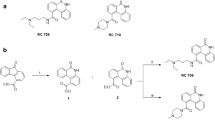Summary
Cytostatic agents often do not discriminate in their cytostatic potential between different tumor cell types in vitro. In this study, several 2-aminothiophene-3-carboxylic acid ester derivatives were discovered that show an unusual cytostatic selectivity for several T-cell (but not B-cell) lymphoma, prostate cancer, kidney carcinoma and hepatoma cell lines. Their 50 % cytostatic concentrations were generally in the higher nanomolar range and were approximately 20- to 50-fold lower for these tumor cell types than for any other tumor cell line or non-tumorigenic cells. The tumor-selective compounds caused a more preferential suppression of protein synthesis than DNA or RNA synthesis and the prototype compound 3 resulted in an accumulation of prostate cancer cells in the G1 phase of their cell cycle. Compound 3 was also shown to induce apoptosis in prostate cancer cells. The 2-aminothiophene-3-carboxylic acid ester derivatives represent novel candidate cytostatic agents to be further explored for their tumor-selective potential.



Similar content being viewed by others
References
Al-Taisan KM, Al-Hazimi HM, Al-Shihry SS (2010) Synthesis, characterization and biological studies of some novel thieno[2,3-d]pyrimidines. Molecules 15:3932–3957
Nikolakopoulos G, Figler H, Linden J, Scammells PJ (2006) 2-Aminothiophene-3-carboxylates and carboxamides as adenosine A1 receptor allosteric enhancers. Bioorg Med Chem 14:2358–2365
Amr A-G, Sherif MH, Assy MG, Al-Omar MA, Ragab I (2010) Antiarrhythmic, serotonin antagonist and antianxiety activities of novel substituted thiophene derivatives synthesized from 2-amino-4,5,6,7-tetrahydro-N-phenylbenzo[b]thiophene-3-carboxamide. Eur J Med Chem 45:5935–5942
Khan KM, Ullah Z, Lodhi MA, Jalil S, Choudhary MI, Atta-Ur-Rahman (2006) Synthesis and anti-inflammatory activity of some selected aminothiophene analogs. J Enzym Inhib Med Chem 21:139–143
Huang Y, Dömling A (2011) The Gewald multicomponent reaction. Mol Divers 15:3–33
Podolin PL, Callahan JF, Bolognese BJ, Li YH, Carlson K, Davis TG, Mellor GW, Evans C, Roshak AK (2005) Attenuation of murine collagen-induced arthritis by a novel, potent, selective small molecule inhibitor of IkappaB Kinase 2, TPCA-1 (2-[(aminocarbonyl)amino]-5-(4-fluorophenyl)-3-thiophenecarboxamide), occurs via reduction of proinflammatory cytokines and antigen-induced T cell Proliferation. J Pharmacol Exp Ther 312:373–381
Romagnoli R, Baraldi PG, Pavani MG, Tabrizi MA, Preti D, Fruttarolo F, Piccagli L, Jung MK, Hamel E, Borgatti M, Gambari R (2006) Synthesis and biological evaluation of 2-amino-3-(3′,4′,5′-trimethoxybenzoyl)-5-aryl thiophenes as a new class of potent antitubulin agents. J Med Chem 49:3906–3915
Romagnoli R, Baraldi PG, Pavani MG, Cruz-Lopez O, Hamel E, Balzarini J, Brognara E, Zuccato C, Gambari R (2010) Synthesis and cellular pharmacology studies of a series of 2-amino-3-aroyl-4-substituted thiophene derivatives. Med Chem 6:329–343
Liou JP, Chang CW, Song JS, Yang YN, Yeh CF, Tseng HY, Lo YK, Chang YL, Chang CM, Hsieh HP (2002) Synthesis and structure-activity relationship of 2-aminobenzophenone derivatives as antimitotic agents. J Med Chem 45:2556–2562
Rhind N, Russell P (2012) Signaling pathways that regulate cell division. Cold Spring Harb Perspect Biol 4:pii: a005942
Han C, Jin L, Mei Y, Wu M (2013) Endoplasmic reticulum stress inhibits cell cycle progression via induction of p27 in melanoma cells. Cell Signal 25:144–149
Zhu GY, Wong BC, Lu A, Bian ZX, Zhang G, Chen HB, Wong YF, Fong WF, Yang Z (2012) Alkylphenols from the roots of Ardisia brevicaulis induce G1 arrest and apoptosis through endoplasmic reticulum stress pathway in human non-small-cell lung cancer cells. Chem Pharm Bull (Tokyo) 60:1029–1036
Waiwut P, Shin MS, Yokoyama S, Saiki I, Sakurai H (2012) Gomisin A enhances tumor necrosis factor-α-induced G1 cell cycle arrest via signal transducer and activator of transcription 1-mediated phosphorylation of retinoblastoma protein. Biol Pharm Bull 35:1997–2003
Chen L, Chen J, Xu H (2012) Sasanquasaponin from Camellia oleifera Abel. Induces cell cycle arrest and apoptosis in human breast cancer MCF-7 cells. Fitoterapia 84C:123–129
Seal S, Chatterjee P, Bhattacharya S, Pal D, Dasgupta S, Kundu R, Mukherjee S, Bhattacharya S, Bhuyan M, Bhattacharyya PR, Baishya G, Barua NC, Baruah PK, Rao PG, Bhattacharya S (2012) Vapor of volatile oils from Litsea cubeba seed induces apoptosis and causes cell cycle arrest in lung cancer cells. PLoS One 7:e47014
Acknowledgments
We are grateful to Mrs. C. Callebaut for dedicated editorial assistance and to Mrs. Lizette van Berckelaer, Kristien Minner and Ria Van Berwaer for excellent technical assistance. The research was supported by the KU Leuven (GOA 10/14). The study sponsors had no role in the writing of the manuscript nor the decision to submit the manuscript for publication.
Conflicts of interest
JB, SL, JT, WD and RR are co-inventors of a patent application filed in June 2012 on the tumor-selective compounds.
Author information
Authors and Affiliations
Corresponding author
Rights and permissions
About this article
Cite this article
Balzarini, J., Thomas, J., Liekens, S. et al. 2-aminothiophene-3-carboxylic acid ester derivatives as novel highly selective cytostatic agents. Invest New Drugs 32, 200–210 (2014). https://doi.org/10.1007/s10637-013-9981-4
Received:
Accepted:
Published:
Issue Date:
DOI: https://doi.org/10.1007/s10637-013-9981-4




